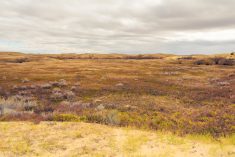CNS Canada — While a wave of snow slowly pummels parts of Saskatchewan and much of Manitoba, one soil moisture expert says water is still trickling through the soil into natural water channels.
According to Trevor Hadwen, agroclimate specialist with Agriculture and Agri-Food Canada’s Drought Watch program in Regina, this is a good thing, as it will help reduce concentrations of water that farmers have to deal with next spring.
“We’re kind of a month behind the temperatures we would normally get,” he said in an interview Monday. “So we’re in a situation where things are fluid at the moment.”
Read Also

Calling for bigger crops ahead of StatCan report
Statistics Canada will release its first survey-based production estimates for the 2025/26 crop year on Dec. 4, with general expectations for upward revisions to most major crops from the model-based estimates in September. However, as StatCan has shown a tendency to underestimate production in its December reports, many analysts expect actual production may be revised upward in subsequent reports.
Frequent rains during the summer and early fall bumped up the moisture reserves across much of Western Canada — so much so that there aren’t any areas where dryness is a concern heading into next year, said Hadwen.
“Basically we’re looking at a fairly abnormal situation: the entire Prairie region does not have a single drought area at this time of year,” he said. “Normally you would have some small region (experiencing) moderate drought.”
However, he said, the area running from central Saskatchewan to southern Manitoba is a bit of a concern right now when it comes to excess moisture.
“Southern Manitoba for sure had a wet fall period and the soil moisture is high,” he said.
The early word is to expect normal to above-normal snowfall this winter, he said, but the situation could change.
For instance, he said, the chance of a La Nina weather event — cooler-than-average sea surface temperatures in the central and eastern tropical Pacific Ocean — seems to be growing.
“If we move to a more La Nina stage we might be seeing a lot more snow this winter; we’re leaning towards La Nina but not fully committed there yet.”
If there is a lot of snow this winter, a long, drawn-out thaw would be preferable.
“Ideally you get that temperature where it gets to +5 C during the day before cooling down at night. That’s kind of what we want.”
February could tell the tale, he said, as it is generally considered the big snow month.
— Dave Sims writes for Commodity News Service Canada, a Winnipeg company specializing in grain and commodity market reporting.
















